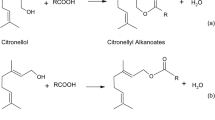Abstract
A highly efficient enzymatic method for the synthesis of regioisomerically pure 1,3-dicapryloyl-2-docosahexaenoyl glycerol (CDC) in two steps was established. 2-Monoglyceride (2-MG) formation by ethanolysis of tridocosahexaenoylglycerol (DDD) with immobilized Candida antarctica lipase (Novozym 435) as catalyst was the key step of the synthesis. CDC was finally obtained by reesterification of 2-MG with ethylcaprylate (EtC) catalyzed by Rhizomucor miehei lipase (Lipozyme IM). The regiospecificity of Novozym 435 depended on the type of reaction and the initial composition of the reaction medium. It displayed strict 1,3-regiospecificity for ethanolysis at a high excess of ethanol in the reaction mixture although it displayed no regiospecificity in transesterification and esterification reactions. The highest yield of CDC (85.4%) was obtained by ethanolysis at a 4∶1 weight ratio of ethanol/DDD for 6 h followed by reesterification at a 20∶1 molar ratio of EtC/initial DDD for 1.5 h. The regioisomeric purity of CDC was 100%. Good results were obtained also for the synthesis of 1,3-dicapryloyl-eicosapentaenoylglycerol (CEC) by the same method: 84.2% yield and 99.8% regioisomeric purity at the same reactant ratios as above. The yield of the reesterification step and the regioisomeric purity of the product were influenced by the molar ratio of the reactants for both CDC and CEC syntheses: higher excess of EtC favored higher yields and regioisomeric purity of the products.
Similar content being viewed by others
References
Emken, E.A., R.O. Adlof, S.M. Duval, and G.J. Nelson, Effect of Dietary Docosahexaenoic Acid on Desaturation and Uptake in Vivo of Isotope-Labeled Oleic, Linoleic, and Linolenic Acids by Male Subjects, Lipids 34:785–791 (1999).
Gill, I., and R. Valivety, Polyunsaturated Fatty Acids, Part 1: Occurrence, Biological Activities and Applications, Tibtech 15:401–409 (1997).
Endo, Y., S. Hoshizaki, and K. Fijimoto, Oxidation of Synthetic Triacylglycerols Containing Eicosapentaenoic and Docosahexaenoic Acids: Effect of Oxidation System and Triacylglycerol Structure, J. Am. Oil Chem. Soc. 74:1041–1045 (1997).
Hedeman, H., H. Brøndsted, A. Mullertz, and S. Frokjaer, Fat Emulsions Based on Structured Lipids (1,3-specific triglycerides): An Investigation of the in Vivo Fate, Pharm. Res. 13:725–728 (1996).
Christensen, M.S., C.E. Høy, C.C. Becker, and T.G. Redgrave, Intestinal Absorption and Lymphatic Transport of Eicosapentaenoic (EPA), Docosahexaenoic (DHA), and Decanoic Acids: Dependence on Intramolecular Triacylglycerol Structure, Am. J. Clin. Nutr. 61:56–61 (1995).
Shimada, Y., A. Sugihara, K. Maruyama, T. Nagao, S. Nakayama, H. Nakano, and Y. Tominaga, Production of Structured Lipid Containing Docosahexaenoic and Caprylic Acids Using Immobilized Rhizopus delemar Lipase, J. Ferment. Bioeng. 81:299–303 (1996).
Iwasaki, Y., J.J. Han, M. Narita, R. Rosu, and T. Yamane, Enzymatic Synthesis of Structured Lipids from Single Cell Oil of High Docosahexaenoic Acid, J. Am. Oil Chem. Soc. 76:563–569 (1999).
Schmid, U., U.T. Bornscheuer, M.M. Soumanou, G.P. Mc Neill, and R.D. Schmid, Optimization of the Reaction Conditions in the Lipase-Catalyzed Synthesis of Structured Glycerides, Ibid. 75:1527–1531 (1998).
Han, J.J., Y. Iwasaki, and T. Yamane, Use of Isopropanol as a Modifier in a Hexane-Acetonitrile Based Mobile Phase for the Silver Ion HPLC Separation of Positional Isomers of Triacylglycerols Containing Long-Chain Polyunsaturated Fatty Acids, J. High Resolut. Chromatogr. 22:357–361 (1999).
Iwasaki, Y., and T. Yamane, Enzymatic Synthesis of Structured Lipids, J. Mol. Catal. B Enzym. 10:129–140 (2000).
Irimescu, R., M. Yasui, Y. Iwasaki, N. Shimidzu, and T. Yamane, Enzymatic Synthesis of 1,3-Dicapryloyl-2-eicosapentaenoylglycerol, J. Am. Oil Chem. Soc. 77:501–506 (2000).
Haraldsson, G.G., B.O. Gudmundsson, and O. Almarsson, The Synthesis of Homogenous Triglycerides of Eicosapentaenoic Acid and Docosahexaenoic Acid by Lipase, Tetrahedron 51:941–952 (1995).
Breivik, H., G.G. Haraldsson, and B. Kristinsson, Preparation of Highly Purified Concentrates of Eicosapentaenoic Acid and Docosahexaenoic Acid, J. Am. Oil Chem. Soc. 74:1425–1429 (1997).
Haraldsson, G.G., B. Kristinsson, R. Sigurdardottir, G.G. Gudmundsson, and H. Breivik, The Preparation of Concentrates of Eicosapentaenoic Acid and Docosahexaenoic Acid by Lipase-Catalyzed Transesterification of Fish Oil with Ethanol, Ibid. 74:1419–1424 (1997).
Irimescu, R., K. Hata, Y. Iwasaki, and T. Yamane, Comparison of Lipase-Catalyzed Acidolysis and Interesterification for Synthesis of 1,3-Dicapryloyl-2-eicosapentaenoylglycerol, Ibid. 78:65–70 (2001).
Author information
Authors and Affiliations
Corresponding author
About this article
Cite this article
Irimescu, R., Furihata, K., Hata, K. et al. Utilization of reaction medium-dependent regiospecificity of Candida antarctica lipase (Novozym 435) for the synthesis of 1,3-dicapryloyl-2-docosahexaenoyl (or eicosapentaenoyl) glycerol. J Amer Oil Chem Soc 78, 285–290 (2001). https://doi.org/10.1007/s11746-001-0258-3
Received:
Accepted:
Issue Date:
DOI: https://doi.org/10.1007/s11746-001-0258-3




